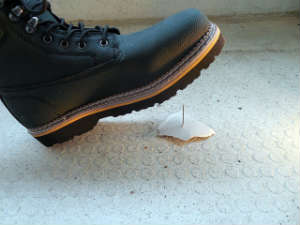Once the province solely of construction workers, nail guns have now become a mainstay in the toolkit of many amateur consumers as well. It’s no secret that nailers increase productivity. The average pneumatic nail gun fires fasteners at a rate of 140 feet per second, far faster than even the most experienced contractor can nail by hand. For DIY home renovators, the gains in efficiency are even greater.
How Common Are Nail Gun Injuries?
But all that power comes at a cost. More construction workers are injured by nailers than any other tool. And as nail guns become common for the general public, the likelihood of nail gun injuries has increased exponentially.
Studying Emergency Room Visits
In 2005, researchers from Duke University’s Medical Center and the National Insitute for Occupational Safety and Health (NIOSH) reviewed five years of emergency room records, and distilled a half-decade worth of numbers on nail gun accidents. Here’s what they found:
On average, 37,000 patients visited emergency rooms each year for treatment involving nailer injuries.
Consumer nail gun injuries increased by more than 250% from 1991 to 2005. In 1991, 4,200 home nail gun owners suffered injury, while between 2001 and 2005 the number hovered around 14,800.
Worker injuries held steady, until skyrocketing in 2005. Between 1998 and 2004, around 20,000 construction workers and carpenters suffered nail gun injuries each year. In 2005, that number jumped to just below 30,000, an increase of almost 40%.
28,000 out of the 28,600 construction workers injured in nailer accidents were men. That’s nearly 98%. Out of those hurt workers, 94% were treated in emergency rooms and then released. Only 6% were hospitalized for treatment resulting from embedded fasteners, broken bones, and infections.
66% of those injuries involved the upper extremities: fingers, hands, and arms. 24% involved lower extremities: legs and feet.
Only 4% resulted in bone fractures. Soft-tissue injuries are far more common, and can cause long-term neurological disability.
Current Data From The US Consumer Product Safety Commission
Using the US Consumer Product Safety Commission’s National Electronic Injury Surveillance System (NEISS) database, we obtained national estimates for the years between 2006 and 2013. Note that these numbers are found by analyzing a select sample of emergency room records and then multiplying that result by the total number of ERs in the United States.
Consumer Nail Gun Injuries (2006 – 2013)
- 2006 – 14,113
- 2007 – 12,366
- 2008 – 11,299
- 2009 – 9,146
- 2010 – 9,179
- 2011 – 8,182
- 2012 – 9,558
- 2013 – 9,027
Obviously, the number of nailer accidents that required medical attention is decreasing. Since 2005, the number of consumers hurt dropped by nearly 40%.
What Changed?
We should think about this decrease as an increase in consumer safety. Nail guns are more popular than ever, so the drop in injuries should probably be attributed to stricter industry regulations and consumer care, rather than a decline in use.
Chief among recent advances is the sequential trip trigger, which limits a nail gun’s firing possibilities, and has been shown to reduce the likelihood of an accident by as much 50%. The American National Standards Institute has brokered an agreement among nailer manufacturers that all pneumatic guns should be shipped with sequential triggers installed, but that’s not legally binding.
For their part, many contractors have pushed back against the safety findings, arguing that sequential triggers make work inefficient and unfeasible.





